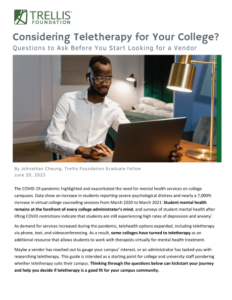Summary
This guide is intended as a starting point for college and university staff pondering whether teletherapy suits their campus. Thinking through the questions below can kickstart your journey and help you decide if teletherapy is a good fit for your campus community.
The COVID-19 pandemic highlighted and exacerbated the need for mental health services on college campuses. Data show an increase in students reporting severe psychological distress and nearly a 7,000% increase in virtual college counseling sessions from March 2020 to March 2021. Student mental health remains at the forefront of every college administrator’s mind, and surveys of student mental health after lifting COVID restrictions indicate that students are still experiencing high rates of depression and anxiety.
As demand for services increased during the pandemic, telehealth options expanded, including teletherapy via phone, text, and videoconferencing. As a result, some colleges have turned to teletherapy as an additional resource that allows students to work with therapists virtually for mental health treatment.
Maybe a vendor has reached out to gauge your campus’ interest, or an administrator has tasked you with researching teletherapy. This guide is intended as a starting point for college and university staff pondering whether teletherapy suits their campus. Thinking through the questions below can kickstart your journey and help you decide if teletherapy is a good fit for your campus community.
1. Why choose teletherapy?
Students may prefer teletherapy because it’s easier to schedule around other activities and allows them to engage online. Research has found that teletherapy and in-person therapy provide equal treatment and outcomes, and college students who use on-campus therapy reported similar approval rates for the quality of care as students who use teletherapy. In addition, teletherapy can enable access to therapists with specializations that can’t be found locally, and colleges concerned about overhead or adding specialized in-house therapists to their campus staff may find teletherapy attractive.
2. Will your campus focus more on mental health or mental wellness?
The phrase “mental health” includes students’ emotional, psychological, and social well-being and generally involves a clinical treatment or component such as therapy, psychiatry, and counseling. Mental wellness, on the other hand, refers to the ability to cope with stress in a healthy way, allowing an individual to live with enjoyment and work productively. Therefore, mental wellness providers will likely focus more on stress management, meditation, and activity reminders. The related but distinct goals require different approaches, and you can begin to narrow down which vendors are suitable for your campus by clarifying the direction you want to go.
3. What are your goals for teletherapy on campus?
You should review current services offered on campus with your counseling center. Ask yourself what the goals of teletherapy are on your campus. Should it fill gaps, offset workloads for on-campus counselors to focus on other treatment areas, or meet another need unique to your institution and student body? Colleges may accomplish these goals in various ways, including, but not limited to, teletherapy. Some campuses have successfully integrated social work and counseling degree programs and their counseling services to provide cost-effective student mental health services.
4. What kind of services do your students need?
Service options include mobile apps, text messaging with a licensed professional, access to online programs and modules, hotlines, and individual or group videoconferencing therapy sessions.
To determine the best fit for your campus, you’ll want to examine the existing capacity and demand for mental health services. You can use on-campus observation, staff and faculty feedback, and student surveys. Then, tailor teletherapy to the needs of students, focusing on areas of support they need most. Broad community input can help optimize student engagement with digital mental health supports.
5. What demographics does your campus serve?
Demographics influence mental health accessibility on campus. For example, 51% of students report that a top barrier to access is a lack of time. Consider the percentage of commuters and the overlap of student class schedules, work hours, and hours for on-campus services before turning to teletherapy. An alternative to teletherapy could be shifting the working hours of on-campus counselors to better coincide with student availability.
In addition, teletherapy can make it easier for some students to find a therapist who puts them at ease. Students of color are more likely to cite stigma and fear (28%) as a significant barrier to mental health treatment than their white peers (9%). Teletherapy can provide access to a diverse pool of providers with the cultural competency to match the needs of your students.
6. What might the financial impacts of teletherapy be on both the school and the student?
Many students (61%) cite financial concerns as their most significant barrier to accessing mental health services. However, student interest in teletherapy and online self-help increased by over 50% when supports were free of charge. Another study found that most college students, especially Black, Latinx, and Asian students, would consider teletherapy if no costs were involved.
Students may find cost savings through teletherapy by reducing the time they need to leave work and removing transportation expenses. Keep this in mind, as vendors charge based on many factors, including the types of services offered, the anticipated caseload of students, and expected availability.
Strong mental health supports are critical to helping students complete their degrees. While not comprehensive, we hope these questions help you think through some of your campus’s unique circumstances as you explore teletherapy options.
As your next step, consider contacting peer institutions about their teletherapy experiences, vendor recommendations, and how they navigated issues like data security and HIPAA compliance. We also recommend reviewing models and guides from nonprofits and mental health groups that assess vendor credibility, user experience, and transparency. For example, the Psyberguide from the University of California Irvine’s Psychological Science Department and this new guide from the American Council on Education are excellent places to start.
About the Author

Johnathan Cheung is recent graduate of the LBJ School of Public Affairs at the University of Texas at Austin. He focuses on education policy, with an emphasis on the intersection of equitable access through poverty alleviation and completion of post-secondary studies through educational intervention. Previously, Johnathan worked at an educational non-profit as an AmeriCorps member and a policy intern at District C in the City of Houston for Councilwoman Ellen Cohen.
He also holds a Bachelor of Science in Political Science from the University of Houston.


